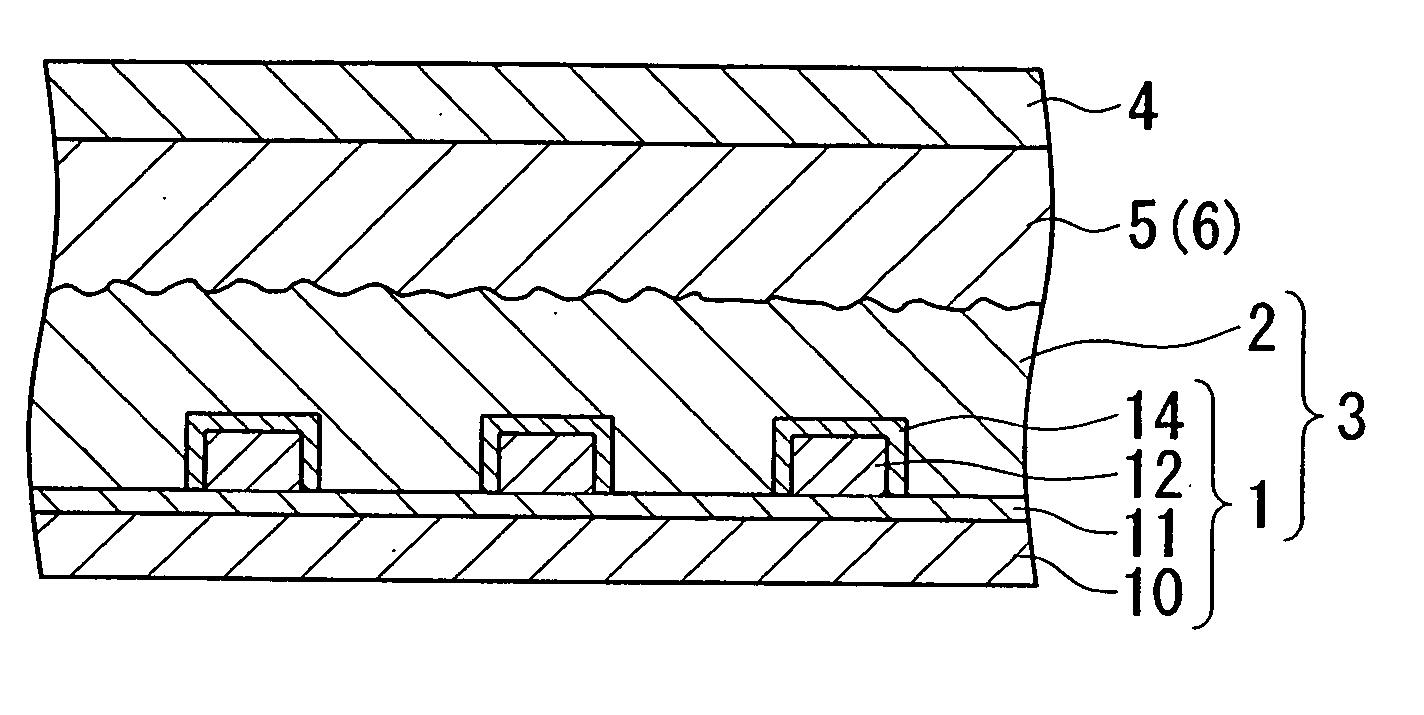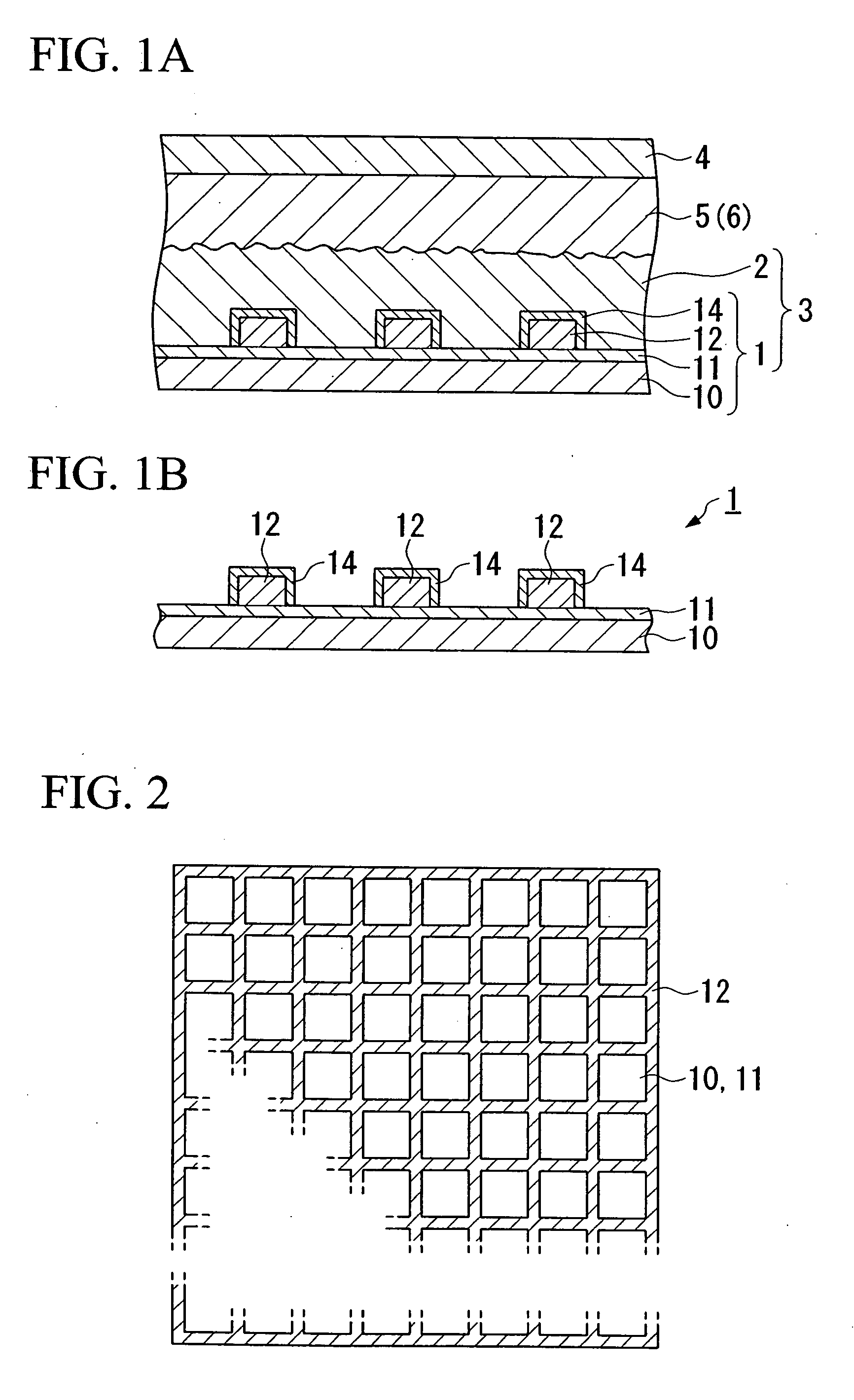Electrode substrate, photoelectric conversion element, conductive glass substrate and production method therefo, and pigment sensitizing solar cell
a technology of photoelectric conversion and conductive glass, which is applied in the direction of electrolytic capacitors, final product manufacture, sustainable manufacturing/processing, etc., can solve the problems of marked deterioration of transmission light ratio, and deterioration of photoelectric conversion efficiency of solar cells, so as to prevent corrosion and leakage current effectively, the effect of excellent conductivity
- Summary
- Abstract
- Description
- Claims
- Application Information
AI Technical Summary
Benefits of technology
Problems solved by technology
Method used
Image
Examples
example a1
(Manufacturing of an Electrode Substrate)
[0100] A 100 mm×100 mm glass substrate provided with an FTO film was used as a transparent conductive layer 11 (11a) and the base material 10. A silver printing paste (having a volume resistivity after baking of 3×10−6Ω) was screen printed on the surface thereof in a lattice pattern. After 10 minutes of leveling, the paste was dried in a hot air circulating furnace at 135° C. for 20 minutes, and was then baked at 550° C. for 15 minutes so as to form the metal circuit layer 12 having a silver circuit. The circuit width of the metal circuit layer 12 was 150 μm, while the film thickness was 5 μm.
[0101] Glass paste was printed overlapping the metal circuit layer 12 by screen printing while alignment was conducted using a CCD camera. After 10 minutes of leveling, the paste was dried in a hot air circulating furnace at 135° C. for 20 minutes, and was then baked at 550° C. for 15 minutes so as to form the insulating layer 14. The width of the ins...
example a2
(Manufacturing of an Electrode Substrate)
[0107] A 100 mm×100 mm heat-resistant glass substrate was used as the base material 10. Using the same procedure as in Example A1, a metal circuit layer 12 having a circuit width of 50 μm and a film thickness of 5 μm was formed on the surface of the substrate using a silver printing paste. Next, an FTO film that was the transparent conductive layer 11 was formed on the metal circuit layer 12 by an SPD method. Furthermore, using the same procedure as in Example A1, the insulating layer 14 was formed by printing glass paste so that the insulating layer 14 corresponds to the pattern of the metal circuit layer 12. As a result, the electrode substrate 3 having the structure shown in FIG. 3 was manufactured.
(Manufacturing of a Photoelectric Conversion Element)
[0108] Using this electrode substrate 1, a photoelectric conversion element was manufactured for use as a test cell using the same procedure as in Example A1. When the photoelectric conve...
example a3
(Manufacturing of Electrode Substrate)
[0109] A 100 mm×100 mm glass substrate provided with an FTO film was used as the transparent conductive layer 11 and the base material 10. A metal circuit layer 12 with a gold circuit having a circuit width of 50 μm and a film thickness of 5 μm was formed on the surface of the transparent conductive layer 11 by an additive plating method. Next, using the same procedure as in Example A1, the insulating layer 14 was formed on top of the metal circuit layer 12 by printing glass paste so that the insulating layer 14 corresponds to the pattern of the metal circuit layer 12. As a result, the electrode substrate 1 having the structure shown in FIG. 1B was manufactured.
(Manufacturing of Photoelectric Conversion Element)
[0110] Using this electrode substrate 1, a photoelectric conversion element was manufactured for use as a test cell using the same procedure as in Example A1. When the photoelectric conversion characteristics of this test cell were e...
PUM
 Login to View More
Login to View More Abstract
Description
Claims
Application Information
 Login to View More
Login to View More - R&D
- Intellectual Property
- Life Sciences
- Materials
- Tech Scout
- Unparalleled Data Quality
- Higher Quality Content
- 60% Fewer Hallucinations
Browse by: Latest US Patents, China's latest patents, Technical Efficacy Thesaurus, Application Domain, Technology Topic, Popular Technical Reports.
© 2025 PatSnap. All rights reserved.Legal|Privacy policy|Modern Slavery Act Transparency Statement|Sitemap|About US| Contact US: help@patsnap.com



